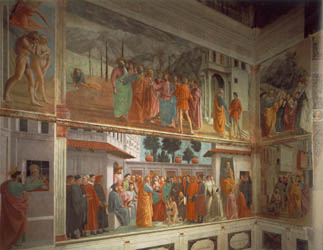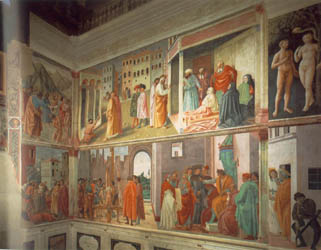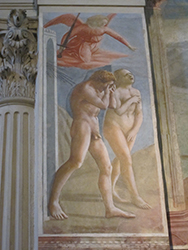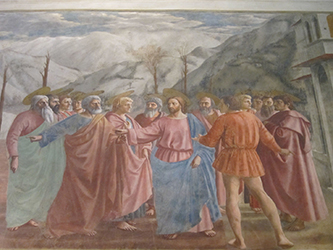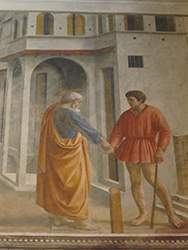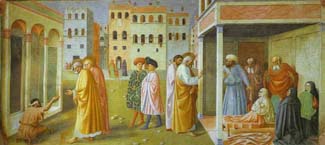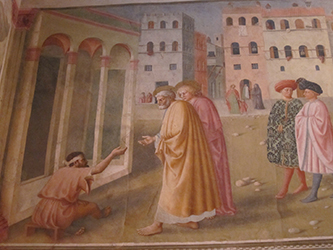Art
Home | ARTH Courses | ARTH 213 Assignments
Brancacci Chapel
in the Church of Santa Maria del Carmine in Florence
Masaccio's frescoes in the Brancacci Chapel play a central role
in any narrative of early fifteenth century Florentine painting. The pictorial
innovations in a fresco like the Tribute Money are given important
emphasis in these histories. Masaccio's use of techniques like linear perspective,
foreshortening, atmospheric perspective, cast shadows, unified light
source, and contrapposto contribute to the coherent sense of space and light
filled environment that seems like an extension of the viewer's space. While
Masaccio in his approach to the formal elements is trying to make the scenes
immediate to the viewer, the subject matter relates episodes from the
life of St. Peter to concerns that would have immediate interest to a Florentine
of the fifteenth century. Instead of the more usual Christological cycle,
the subjects of the frescoes focus on the involvement of the church
in the person of Peter in social life. Consider the frescoes and their
likely textual sources, and see their relevance to civic life of Florence.
The chapel
was the result of a bequest of Pietro Brancacci, who died in 1367. The
choice of episodes from the life of the St. Peter as the subject matter
of the frescoes likely reflects the wishes of Pietro. After the deaths
of Pietro's brothers and sons, the chapel past down to a nephew, Felice
Brancacci.
It is understood that Felice was responsible for the commissioning of the
frescoes. Felice's political alliance with Palla Strozzi was cemented by
his second marriage to the daughter of Palla Strozzi. With the exile of
Strozzi in 1434, Felice was charged with political intrigue and was himself
exiled in 1435. The prominence of St. Peter in the Brancacci cycle perhaps
also reflects Felice's strong ties to the Papacy in Rome. Although not
certain, most scholars conjecture that Masolino was given the original
commission
of
the work.
He was responsible
for the
frescoes on the upper register of the right wall, while Masaccio was given
responsibility for those on the left. They apparently shared responsibility
for the altar wall. While Masaccio's activity can be seen in the lower
register that was largely completed by Filippino Lippi, Masolino's work
is limited to the upper register. A fire in 1748 destroyed the original
frescoes in the vault and lunettes. Following the regular practice in fresco
painting of beginning at the top and working down, it seems plausible that
Masolino's activity began with the ceiling and then worked down to the
upper register with Masaccio picking up at this point.
Expulsion
of Adam and Eve (Masaccio). Note how the pose of Eve is apparently based on the so-called Venus Pudica pose that became the norm for the nude Aphrodite figures in the Late Classical period: 
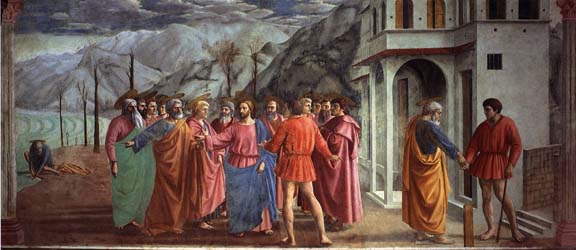
The Tribute Money
(Masaccio)
Matthew 17:23 And when they were come to Capharnaum, they that received the
didrachmas, came to Peter, and said to him: Doth not your master pay the didrachma?
24 He said: Yes. And when he was come into the house, Jesus prevented him, saying:
What is thy opinion, Simon? The kings of the earth, of whom do they receive
tribute or custom, of their own children, or of strangers?
25 And he said: Of strangers. Jesus said to him: Then the children are free.
26 But that we may not scandalize them, go to the sea, and cast in a hook: and
that fish which shall first come up, take: and when thou hast opened it's mouth,
thou shalt find a stater: take that, and give it to them for me and thee.

Horizon Line
|
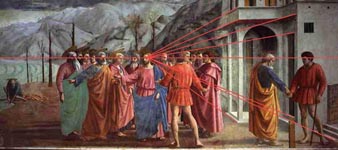
Orthogonals
|
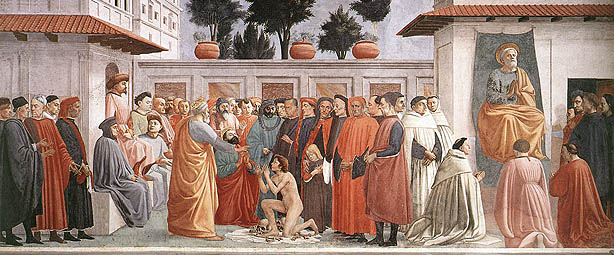
Raising
the Son of Theophilus and St. Peter Enthroned (Filippino Lippi and
Masaccio): According to
the account in the Golden
Legend: "Suddenly a light appeared there, and all the sick people were
guerished [healed] and healed of whatsomever malady they had. And that same
day the Holy Ghost showed so greatly his grace, that from the least unto
the most, all believed in our Lord Jesu Christ. And there were baptized in
seven days more than ten thousand persons of men, women, and children, and
also Theophilus, the lord and provost of the city, to whom St. Peter had
raised his son which had been fourteen years dead.
And some say that of his palace he made a church in the which all the people
set up a chair for St. Peter to sit in more higher, for to preach the doctrine
of Jesu Christ, and the better to be heard and seen. And of the exalting
thus of St. Peter into this chair, this feast taketh the name of the chairing
of St. Peter. And in this church was St. Peter seven years, and from thence
he went to Rome and governed the church of Rome twenty-five years."

St. Peter Preaching (Masolino)
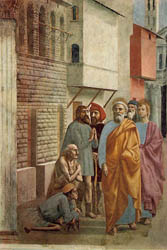
St. Peter Healing
with his Shadow (Masaccio), Acts 5: 12-16: And by the hands of
the apostles were many signs and wonders wrought among the people. And
they were
all with
one
accord
in Solomon's porch.
13 But of the rest no man durst join himself unto them; but the people magnified
them.
14 And the multitude of men and women who believed in the Lord, was more increased:
15 Insomuch that they brought forth the sick into the streets, and laid them
on beds and couches, that when Peter came, his shadow at the least, might overshadow
any of them, and they might be delivered from their infirmities.
16 And there came also together to Jerusalem a multitude out of the neighboring
cities, bringing sick persons, and such as were troubled with unclean spirits;
who were all healed.
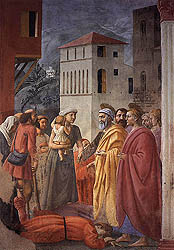
Distribution of
Communal Goods and the Death of Ananias (Masaccio):
Acts 5: 1 But a certain man named Ananias, with Saphira his wife, sold a piece
of land,
2 And by fraud kept back part of the price of the land, his wife being privy
thereunto: and bringing a certain part of it, laid it at the feet of the apostles.
3 But Peter said: Ananias, why hath Satan tempted thy heart, that thou shouldst
lie to the Holy Ghost and by fraud keep part of the price of the land?
4 Whilst it remained, did it not remain to thee? And after it was sold, was
it not in thy power? Why hast thou conceived this thing in thy heart? Thou hast
not lied to men, but to God.
5 And Ananias, hearing these words, fell down and gave up the ghost. And there
came great fear upon all that heard it.
6 And the young men rising up, removed him, and carrying him out, buried him.
7 And it was about the space of three hours after, when his wife, not knowing
what had happened, came in.
8 And Peter said to her: Tell me, woman, whether you sold the land for so much?
And she said: Yea, for so much.
9 And Peter said unto her: Why have you agreed together to tempt the spirit
of the Lord? Behold the feet of them who have buried thy husband are at the
door: and they shall carry thee out,
10 Immediately, she fell down before his feet and gave up the ghost. And the
young men coming in found her dead: and carried her out and buried her by her
husband.
11 And there came great fear upon the whole church and upon all that heard these
things.
12 And by the hands of the apostles were many signs and wonders wrought among
the people. And they were all with one accord in Solomon's porch.
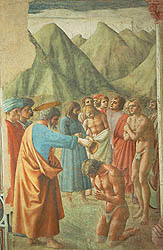
St. Peter Baptizing (Masaccio).
St. Peter Raising
Tabitha and the Healing of the Lame:
Acts 9:36 And in Joppe there was a certain disciple named Tabitha, which by
interpretation is called Dorcas. This woman was full of good works and almsdeeds
which she did.
37 And it came to pass in those days that she was sick and died. Whom when they
had washed, they laid her in an upper chamber.
38 And forasmuch as Lydda was nigh to Joppe, the disciples, hearing that Peter
was there, sent unto him two men, desiring him that he would not be slack to
come unto them.
39 And Peter rising up went with them. And when he was come, they brought him
into the upper chamber. And all the widows stood about him, weeping and shewing
him the coats and garments which Dorcas made them.
40 And they all being put forth, Peter, kneeling down, prayed. And turning to
the body, he said: Tabitha, arise. And she opened her eyes and, seeing Peter,
sat up.
41 And giving her his hand, he lifted her up. And when he had called the saints
and the widows, he presented her alive.
42 And it was made known throughout all Joppe. And many believed in the Lord.
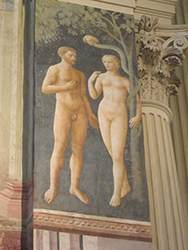 |
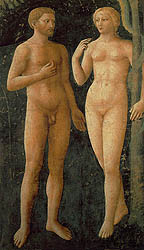 |
Temptation of Adam
and Eve (Masolino)
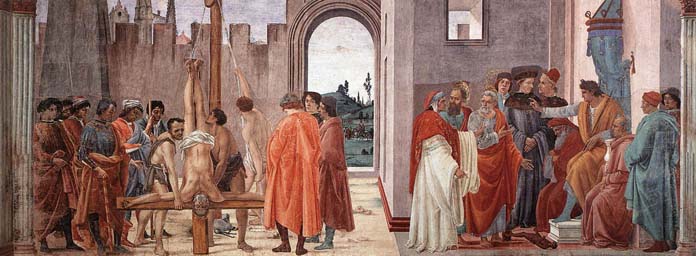
Crucifixion of
St. Peter and Disputation with Simon Magus before the Emperor Nero(Filippino Lippi)
The story of Peter's debate with Simon Magus before the Emperor Nero and the
account of St. Peter's Crucifixion upside down do not appear in the canonical
texts of the New Testament. Both stories do appear in the most popular late
Medieval compendium of Saints lives, The
Golden Legend.
The frescoes of Filippino Lippi incorporate the heads of contemporary Florentines, including a self-portrait as the figure on the far right of the scene of the Disputation with Simon Magus. The head of the Emperor Nero in this fresco is clearly based on Roman images of the emperor as represented by the obverse of a coin:
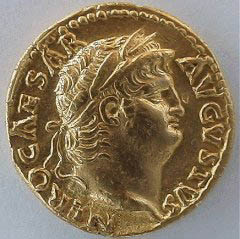

St. Paul visiting St. Peter in Prison
(Filippino Lippi)
|
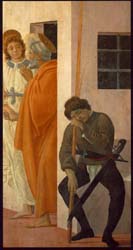
St. Peter released from Prison
(Filippino Lippi)
|
Acts 12: 1 AND at the same time, Herod the king stretched forth his hands,
to afflict some of the church.
2 And he killed James, the brother of John, with the sword.
3 And seeing that it pleased the Jews, he proceeded to take up Peter also.
Now it was in the days of the Azymes.
4 And when he had apprehended him, he cast him into prison, delivering him
to four files of soldiers to be kept, intending, after the pasch, to bring
him forth to the people.
5 Peter therefore was kept in prison. But prayer was made without ceasing by
the church unto God for him.
6 And when Herod would have brought him forth, the same night Peter was sleeping
between two soldiers, bound with two chains: and the keepers before the door
kept the prison.
7 And behold an angel of the Lord stood by him: and a light shined in the room:
and he striking Peter on the side, raised him up, saying: Arise quickly. And
the chains fell off from his hands.
8 And the angel said to him: Gird thyself, and put on thy sandals. And he did
so. And he said to him: Cast thy garment about thee, and follow me.
9 And going out, he followed him, and he knew not that it was true which was
done by the angel: but thought he saw a vision.
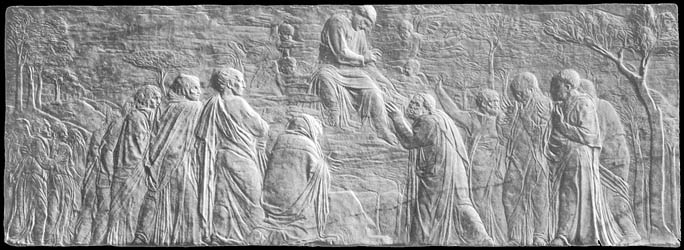
Donatello, Ascension
of Christ and the Giving of the Keys to St. Peter, c.
1425-1430.
Listed in
the Medici collection in 1492, this shallow now in the Victoria and Albert
Museum in London was perhaps originally commissioned by the Brancacci family
as a predella for
their altar.
The prominence
of
St. Peter in this relief and the close parallels to the work of Masaccio
in the Brancacci Chapel lend credence to this conclusion. Both Masaccio and
Donatello worked in Pisa in 1426, and a bearded beggar in the Brancacci
Chapel of St. Peter curing with his shadow has been identified as a portrait
of Donatello. This relief perhaps entered the Medici collection in 1435 when
the possessions of Felice Brancacci were confiscated when he was exiled.
Useful Links:
Visit
to the Brancacci Chapel, Web Gallery of Art.
Cappella
Brancacci, Christus
Rex.
Art
Home | ARTH Courses | ARTH
213 Assignments

